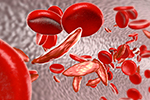
A powerful technique called CRISPR is taking us closer to the goal of repairing genetic diseases, including sickle cell disease. This disease is caused by a single change in the genetic code of the gene used to make the hemoglobin protein.
Hemoglobin not only makes our blood red, it delivers life sustaining oxygen to our tissues. But the mutated gene in sickle cell disease creates an altered form of hemoglobin that causes red blood cells to change from disk shaped cells to sickle-shaped ones. These blood cells cannot pass through smaller blood vessels and thus the surrounding tissues become damaged from a lack of oxygen.
The new treatment uses CRISPR, a molecular tool which was discovered in a marsh bacterium. Since then, researchers have harnessed it to alter DNA within the genome of a living cell.
In sickle cell disease, scientists were able to use CRISPR to remove the mutated DNA sequence and introduce the correct sequences so that a quarter of the cells contain normal hemoglobin. In this study, they used CRISPR to remove the defective gene, then used an engineered virus to provide the corrected gene sequences. They were able to repair up to half the defective cells.
When this method was used on diseased mice, the repaired cells became a stable population in the bone marrow, which means they could make normal blood cells for years and maybe even a lifetime. The results are so promising, researchers are pushing for human trials as soon as 2018.
The exciting goal of this type of research is to one day repair many human genetic diseases.
More Information
What Is Sickle Cell Disease?
The term sickle cell disease (SCD) describes a group of inherited red blood cell disorders. People with SCD have abnormal hemoglobin, called hemoglobin S or sickle hemoglobin, in their red blood cells.
Genetic Treatments for Sickle Cell
When it comes to a devastating blood disorder, sometimes two wrongs make a right...
Sickle cell disease once meant a short and painful life, but now there's growing hope
New research and better and more aggressive treatment have begun to change sickle cell disease from an inherited condition that often condemned children to painful and short lives into a condition that can be managed with less pain and has a better life expectancy...